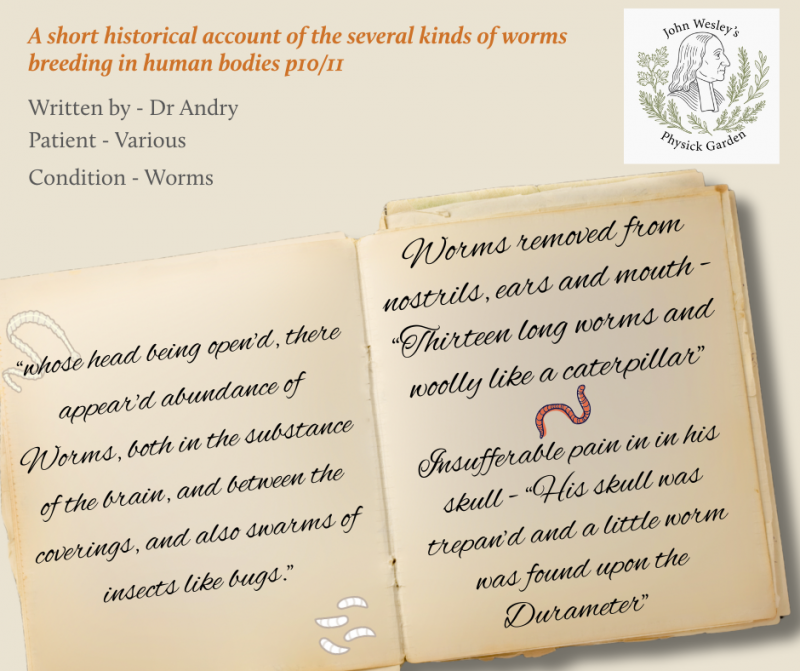The numbers listed under each plant are the number of the remedy as it appears in the 1780 edition of Primitive Physick.
Lavender (Lavendula augustfolia)
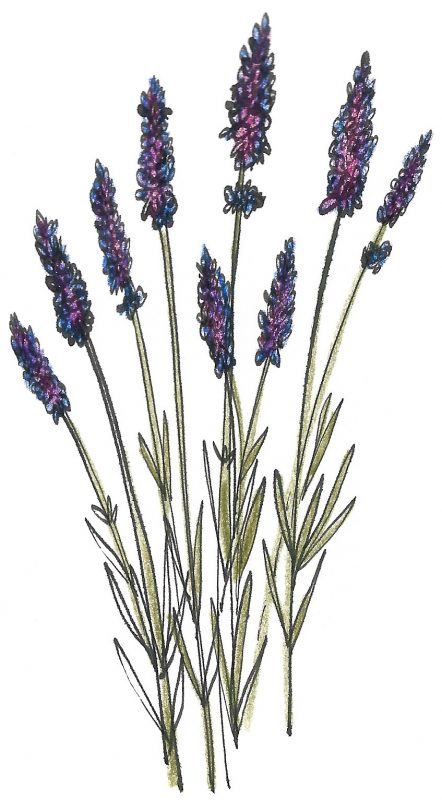 Lavender was probably introduced by the Romans, although its history is lost in the mists of time. It was grown in monastery gardens and was one of the herbs taken to America by the Pilgrim Fathers. The Latin word lavandus means to be washed. Lavender conserve was a favourite of Queen Elizabeth I. In a powdered form it took its place at the table, alongside salt and pepper.
Lavender was probably introduced by the Romans, although its history is lost in the mists of time. It was grown in monastery gardens and was one of the herbs taken to America by the Pilgrim Fathers. The Latin word lavandus means to be washed. Lavender conserve was a favourite of Queen Elizabeth I. In a powdered form it took its place at the table, alongside salt and pepper.
Wesley’s recommendations:
126 – The Headache – snuff up the nose camphorated spirits of lavender
252 – Tonsils Swelled – wash them well with lavender water
Other Therapies
Lavender has been used since ancient times for its therapeutic properties and perfume. It is calming, soothing, emotionally balancing, antiseptic, antibacterial and painkilling. It has been found to have amazing healing properties in the case of burns and is one of the few aromatherapy oils that can be applied neat to the skin.
Peony (paeonia)
Peonies have a long history, being grown in the east since 900BC. Peonies were popular medicinal herbs in Britain up to the 16th century
Wesley’s recommendations:
101 – The Falling Sickness – take a teaspoon of peony root, dried and grated fine, morning and evening for three months.
In the falling sickness the patient falls to the ground either quite stiff or convulsed all over, utterly senseless, gnashing his teeth and foaming at the mouth – JOHN WESLEY
Other therapies
In ancient Greco-Roman times the peony was often combined with mistletoe to treat seizure and epilepsy. In Traditional Chinese Medicine, white peony root (Bai Shao) is used to nourish blood, soothe the liver and support hormonal imbalance. It also possesses anti-inflammatory, immunomodulatory, and antioxidant properties.
Marjoram (Origanum majorana)
In some Middle Eastern countries, marjoram is synonymous with oregano, and there the names sweet marjoram and knotted marjoram are used to distinguish it from other plants of the genus Origanum. It may have spread to the British Isles during the Middle Ages.
Wesley’s recommendations:
129 – A Nervous Headache – Dry and powder an ounce of marjoram and half an ounce of assarabacca; mix them and take them as snuff, keeping ears and throat warm. This is of great use even in a cancer, but it will suffice to take a small pinch every other night, lying down in bed.
Other therapies
Marjoram has long been used as a medicinal herb. Marjoram or marjoram oil has been used to treat cancer, colds, coughs, cramps, depression, ear infections, gastrointestinal problems, headaches, and paralysis, as well as arthritis, chest congestion, muscle aches, and as a diuretic. It has also been used as an aphrodisiac, mouthwash, tea, and in poultices, tinctures, and infusions.
Wild Strawberry (fragaria vesca)
The wild strawberry, is also called the woodland strawberry, Alpine strawberry, Carpathian strawberry or European strawberry, and is a perennial herbaceous plant in the rose family that grows naturally throughout much of the Northern Hemisphere. Evidence from archaeological excavations suggests that wild strawberries have been eaten by humans since the Stone Age.
Wesley’s recommendations:
176 – The Pleurisy – To appease the cough take often, a little at a time of roasted apples, strawberries, raspberries or currants
Other therapies
Preparations made from strawberry fruits are used to treat certain types of anemia, and the leaves, which have astringent and diuretic properties are used for liver disease and jaundice.
Thyme (Thymus vulgarus)
The history of thyme goes back to its use in ancient Babylon. The Greeks and Romans used it as a strewing herb and the name Thymus comes from the Greek thuo, which means to perfume. In the Middle Ages ladies would give their knights sprigs of thyme, or hand embroidered favours showing a bee hovering over a sprig of thyme, in the hope that it would give courage.
Wesley’s recommendations:
161 – Nervous disorders – The patient should rise early and as soon as the dew is off the ground; let his breakfast be mother of thyme tea, gathered in June, using half as much as we do of common tea. Or, the common garden thyme if the former cannot be procured.
Other therapies
Thyme is a very popular and widely used herb both for cooking and medicinally. It has antiseptic, antibacterial, anti-fungal, properties and is an expectorant and digestive tonic.
Box (Buxus sempervirens)
Box is a native plant of North America, Western Asia and Europe. The common name “box” comes from the Latin buxus, which in turn comes from the Greek puxus, meaning a small box. The wood does not warp so was used for instruments which had to be taken to sea. A perfume was once made from its bark and an auburn hair dye was made from a mixture of box leaves and sawdust.
Wesley’s recommendations:
11 – To cure baldness – wash it with a decoction of boxwood
Other therapies
All parts of the plant are considered TOXIC, especially the leaves and seeds. Animals such as cows, sheep and goats have died as a result of eating the leaves. It is used medicinally by homeopaths to treat rheumatism and urinary tract infections.
Bay (Laurus noblis)
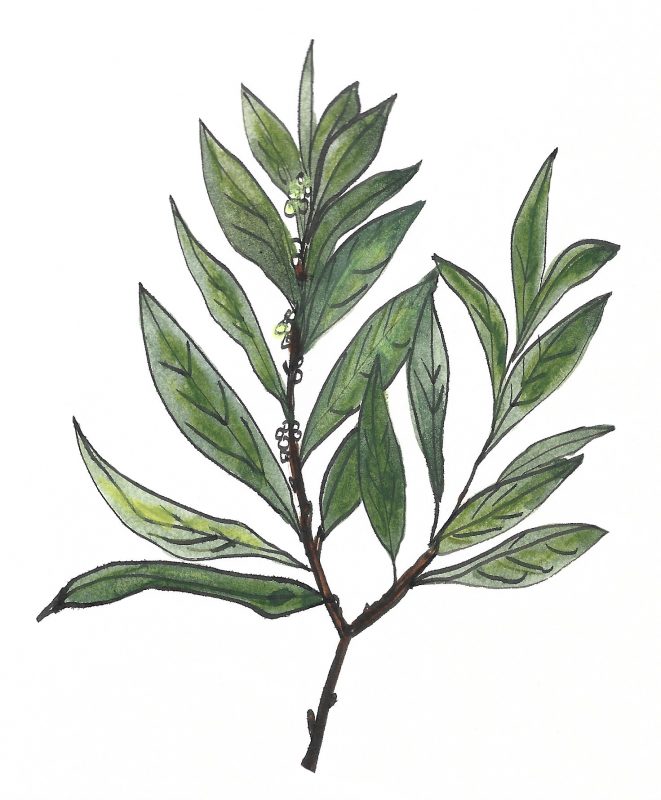 This evergreen tree in a native of the Mediterranean. It was sacred to Apollo, Greek god of prophecy, poetry and healing. His priestesses ate bay leaves before giving prophecies at the oracles at Delphi. The roof of the temple was thatched with bay leaves. It was respected by the Romans when a bay wreath was a mark of excellence for poets and athletes, a symbol of wisdom and glory
This evergreen tree in a native of the Mediterranean. It was sacred to Apollo, Greek god of prophecy, poetry and healing. His priestesses ate bay leaves before giving prophecies at the oracles at Delphi. The roof of the temple was thatched with bay leaves. It was respected by the Romans when a bay wreath was a mark of excellence for poets and athletes, a symbol of wisdom and glory
Wesley’s recommendations:
88 – Films (over the eyes) – mix juice of ground ivy with a little honey and tow or three grains of bay salt. Drop it in morning and evening
Blindness is often cured by cold bathing, or, by electrifying – This has cured a suffusion of sixteen, and a gutta serena of twenty-four years standing – JOHN WESLEY
A suffusion of the eye could be a redness or swelling on the white of the eye. Gutta serena is a condition of partial or complete blindness with a transparent pupil
Other therapies
Its leaves are used in cooking to aid digestion, especially of meat. It also has properties that relax and lift the spirit.
Dandelion (taraxacum officinalis)
All the names for this plant refer to a lion’s tooth. In Medieval Latin it is called “tooth of the Lion”, but this may mean only part of the flower: the tap root or the jagged leaf. It was known as a diuretic from the 16th century.
Wesley’s recommendations:
63 – Violent coughing from a sharp and thin rheum – The milky juice of all sowthistles, dandelions and lettuces, have nearly the same virtues.
Other therapies
The leaves, flowers and roots of the dandelion are all used extensively in herbal medicine. Flowers and leaves are also cultivated in some parts of the world as salad plants. The plant is used as a diuretic and kidney tonic. It has excellent cleansing properties.
Potentilla / Cinquefoil (Hypericum perforatum)
Potentillas are also called cinquefoils in English, but they have also been called five fingers and silverweeds. Typical cinquefoils look most similar to strawberries, but differ in usually having dry, inedible fruit (hence the name “barren strawberry” for some species).
Wesley’s recommendations:
208 – A Sore Mouth – gargle with juice of cinquefoil
An old sore throat was cured by living wholly upon apples and apple water – JOHN WESLEY
Other therapies
Some species are used in herbalism for inflammation and gastrointestinal disorders. Research continues to determine its safety and usefulness as an alternative medicine for such disorders as ulcerative colitis.
Radish (Raphanus sativus)
They are thought to be native to Asia but were domesticated in the Mediterranean region. Radishes have been grown for centuries and are depicted in the pyramid of Cheops. They were cultivated by the Egyptians in 2780BC and Herodatus noted that workers on the pyramids received radishes, onions and garlic as their rations. Models of radishes were dedicated to Apollo in the temple at Delphi.
Wesley’s recommendations:
10 – Dry Asthma– juice of radishes relieves much
135 – Hoarseness – swallow slowly the juice of radishes
Other therapies
Asaph the Jew, perhaps the earliest known Hebrew medical writer, noted that the radish, particularly its leaves, may be useful in traditional medicine to increase mucus. During the Middle Ages, Ibn Wahshiyya an Iraqi alchemist used it in antidotes for poisons.
Stinging Nettle (Urtica dioica)
The species is divided into six subspecies, five of which have many hollow stinging hairs called trichomes on the leaves and stems, which act like hypodermic needles, injecting histamine and other chemicals that produce a stinging sensation upon contact. The nettle is one of the nine plants invoked in the pagan Anglo-Saxon Nine Herbs Charm, recorded in 10th-century traditional medicine.
Wesley’s recommendations:
135 – Hoarseness – take dry nettle roots in an oven; then powder them finely, and mix with an equal quantity of treacle. Take a tea0spoonful twice a day
176 – The Pleurisy – take a decoction of nettles and apply the boiled herb hot as a poultice.
244 – To cure the toothache – lay bruised or boiled nettles to the cheek.
Other therapies
Nettles have been used as a folk remedy for treating rheumatism. A study undertaken in 2000 showed that nettles were an effective therapy in relieving the pain of arthritis.
Old Age – take tar water morning or evening or a decoction of nettles; either of these will probably renew their strength for some years – JOHN WESLEY
Horseradish (amoracia rusticana)
Horseradish has been cultivated for many hundreds of years. The Roman author and naturalist, Pliny the Elder’s referenced it in his Natural History as having medicinal qualities and his predecessor, Cato discusses the plant in his treatises on agriculture. A mural in the ancient Roman city of Ostia Antica, shows the plant. The early Renaissance herbalists Pietro Andrea Mattioli and John Gerard also noted its use. The physician William Turner, working in the 16th century mentions horseradish as ‘red cole’ in his “Herbal”.
Wesley’s recommendations
58 – A Consumptive Cough – to stop it for a time, at lying down keep a little stick of liquorice shaved like horse-radish between the cheek and gums. I believe this never fails.
126 – The Headache – snuff up the nose….a little of horse-radish
Other therapies:
The root of the Horseradish plant is used extensively. Its high vitamin C content makes it useful for the treatment of infectious diseases of the respiratory system and digestive tract. It has been used externally to treat inflammations and swellings.
Hyssop (Hyssopus officinalis)
Hyssop is a native of southern Europe and was probably introduced to the UK by the Romans. Long ago this herb was regarded as a symbol or purification and was used for cleansing churches and leprous houses. It was an important plant in the infirmary gardens of monasteries as it was also used in the making of liqueurs such as Benedictine and Chartreuse.
Wesley’s recommendations:
83 – A blood-shot eye – apply boiled hyssop as a poultice. This has wonderful efficacy.
176 – The Pleurisy – sip hyssop tea
“Sip almost continually thin whey, barley water, or hyssop tea, sharpened with vinegar and water or lemon juice” – Dr. John Huxham (1692 – 1768)
Other therapies
Hyssop was revered by the Hebrews and ancient Greeks as a cleansing herb. It is still a valued plant for its medicinal properties. Both the leaves and flowers are distilled for their essential oil, but is an oil that needs to be treated with respect as there is some risk of TOXICITY. It is used in the treatment of catarrh and chest infections and is an excellent head clearing oil.
Valerian (Valeriana officinalis)
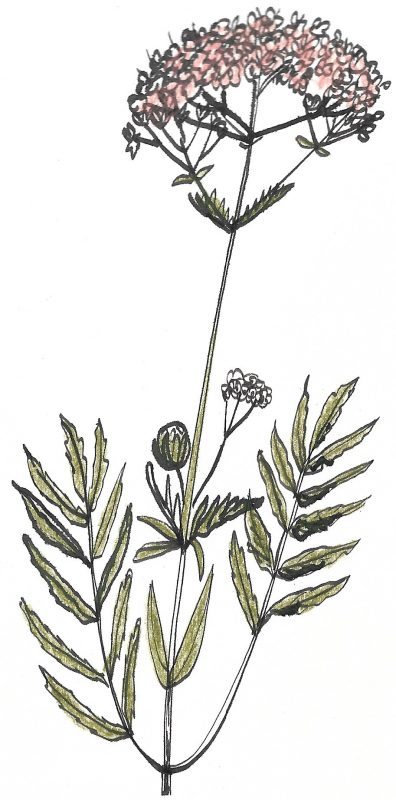 This is a native of Europe and West Asia. The name may come from the Latin valere, to be healthy or from the name of an early herbalist, Valeris, who first used it medically. Cats and rats are attracted to the smell and the Pied Piper of Hamlin is said to have carried valerian root. In the First and Second World Wars a tincture of valerian root was used to treat shell shock and nervous tension.
This is a native of Europe and West Asia. The name may come from the Latin valere, to be healthy or from the name of an early herbalist, Valeris, who first used it medically. Cats and rats are attracted to the smell and the Pied Piper of Hamlin is said to have carried valerian root. In the First and Second World Wars a tincture of valerian root was used to treat shell shock and nervous tension.
Wesley’s recommendations:
50 – Convulsions – Take a teaspoon of Valerian root powdered in a cup of water every evening
101 – The Falling Sickness – half a spoonful of valerian root, powdered three time daily, ina glass of water for three months
161 – Nervous Disorders – When the person finds an uncommon oppression, let him take a large spoonful of tincture of valerian root
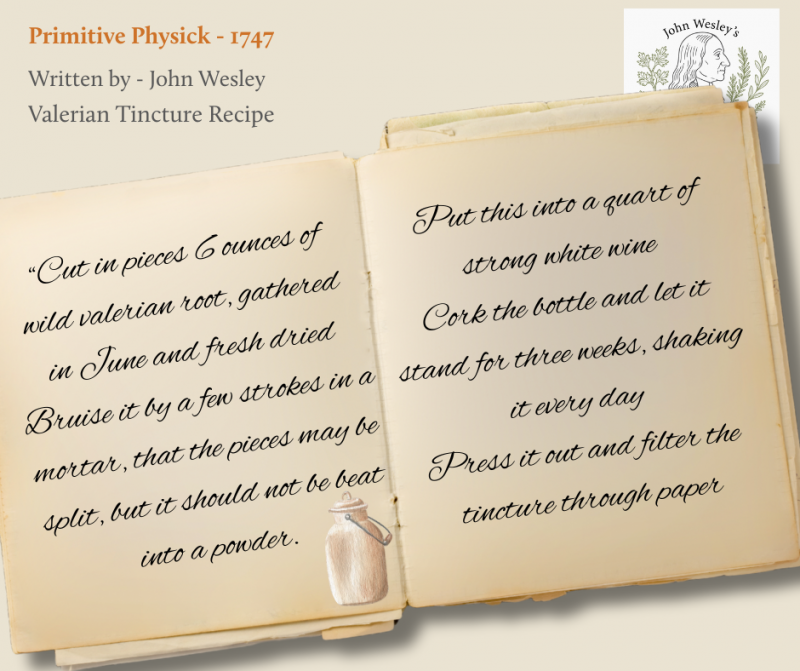
Other therapies
Valerian is used to treat a range of disorders associated to anxiety and nervous tension including insomnia, migraine and depression.



